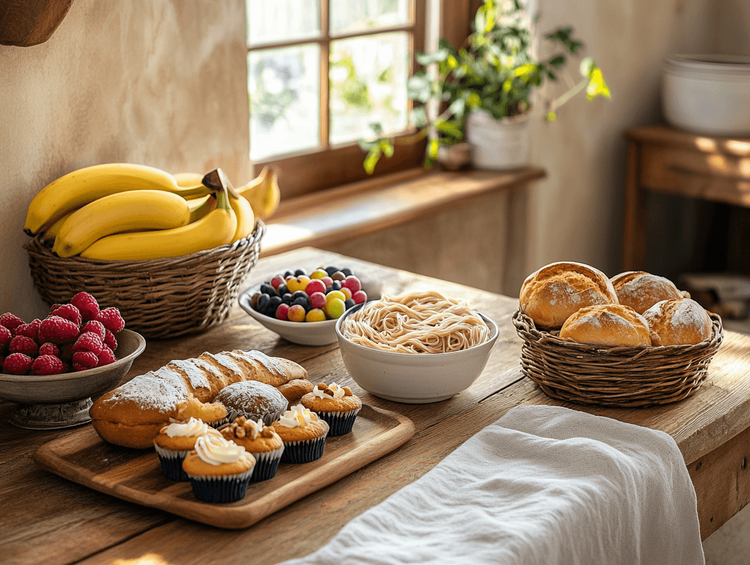Top 100+ Easy Collective Noun Examples-Best Guide for Students

Table of Contents
- What is a Collective Noun?
- 100+ Collective Noun Examples
- How to Use Collective Nouns in Sentences
- Key Characteristics of Collective Nouns
- Why Are Collective Nouns Important?
- Common Mistakes to Avoid
- Fun Ways to Learn Collective Nouns (Great for Kids!)
- Learn Collective Nouns the Fun Way – Join PlanetSpark’s Engl
- Conclusion
- FAQs on Collective Noun Examples
Tired of losing marks in grammar just because collective nouns seem tricky? Here’s the easiest way to understand them with real examples that you’ll remember in seconds.
In this blog, you'll discover what collective nouns are, over 100+ examples across categories, and how to use them correctly, Whether you're a student, parent, or teacher, this guide will help you explore collective nouns in depth. And if you're looking to boost your grammar skills further, PlanetSpark's Live 1:1 English Grammar Course offers personalized coaching, games-based learning, and expert guidance to make learning both fun and effective.
What is a Collective Noun?
A collective noun is a word used to represent a group or collection of people, animals, or objects considered as a single whole. Instead of listing each item or individual in a group, a collective noun provides a shortcut to refer to the entire group in one term. For instance, instead of saying “ten singers,” we can say “a choir.”
These nouns make language more efficient and help reduce repetition. For example:
- “A herd of elephants” sounds more natural and fluid than “a group of elephants.”
- “A panel of judges” captures professionalism and structure better than “a group of judges.”
100+ Collective Noun Examples
Let’s explore over 100 examples of collective nouns, categorized for easier learning and reference.
Collective Noun Examples for People
- A team of athletes
- A class of students
- A choir of singers
- A crowd of spectators
- A panel of experts
- A troupe of dancers
- A committee of managers
- A crew of workers
- A congregation of worshippers
- An audience of listeners
- A staff of employees
- A band of musicians
- A gang of thieves
- A board of directors
- A group of tourists
Usage Tip: These are frequently used in school environments, corporate setups, and public performances.
Collective Noun Examples for Animals
- A flock of birds
- A herd of elephants
- A pack of wolves
- A pride of lions
- A school of fish
- A colony of bats
- A troop of monkeys
- A swarm of bees
- A gaggle of geese
- A litter of puppies
- A drove of cattle
- A hive of bees
- A flight of swallows
- A parade of elephants
- A clowder of cats
Fun Fact: Many animal collective nouns have poetic and whimsical names that add richness to the language.
Collective Noun Examples for Objects and Things
- A bunch of keys
- A pile of books
- A stack of boxes
- A bundle of clothes
- A deck of cards
- A row of houses
- A set of tools
- A collection of coins
- A group of islands
- A series of events
- A string of pearls
- A batch of documents
- A fleet of cars
- A library of books
- A cluster of stars
Common Use: These are found in everyday writing, technical documents, and descriptive scenes.
Collective Noun Examples for Food
- A loaf of bread
- A bunch of bananas
- A jar of pickles
- A plate of cookies
- A bowl of noodles
- A tray of cupcakes
- A stack of pancakes
- A glass of milk
- A pack of chips
- A bottle of soda
- A scoop of ice cream
- A barrel of apples
- A basket of fruits
- A pack of biscuits
- A box of chocolates
Unique and Rare Collective Noun Examples
- A murder of crows
- A parliament of owls
- A leap of leopards
- A crash of rhinoceroses
- A convocation of eagles
- A shrewdness of apes
- A skulk of foxes
- A dazzle of zebras
- A sounder of swine
- An ambush of tigers
How to Use Collective Nouns in Sentences
Understanding collective nouns is not just about memorizing lists; it’s about knowing how to use them effectively in real sentences.
Rule 1: Use Singular Verbs When the Group Acts as One
- The class is preparing for the final exam.
- The team wins every match.
Rule 2: Use Plural Verbs When Individuals Act Separately
- The jury are still arguing among themselves.
- The staff have submitted their individual reports.
Rule 3: Pay Attention to Context and Meaning
- A flock of birds flying in formation = singular verb
- A flock of birds scattering in different directions = plural verb
Key Characteristics of Collective Nouns
- Singular in Form, Dual in Function: While collective nouns are grammatically singular, they can take singular or plural verbs based on context.
- Used in Both Formal and Informal Settings: They are common in academic writing, spoken English, fiction, journalism, and classroom instruction.
- Improve Language Economy: They make sentences shorter without losing meaning.
- Aid in Visualization: Words like “a flock of birds” paint a more vivid picture than generic alternatives.
Examples Include:
- A group of dancers
- A batch of cookies
- A swarm of bees
- A team of engineers
- A bouquet of flowers
Why Are Collective Nouns Important?
Collective nouns do more than just make your sentences shorter. They enhance fluency, clarity, and expression in both written and spoken communication. Here are several reasons why mastering them is essential:
Elevate Communication
When you use collective nouns, your language becomes more fluid and natural. You can convey complex ideas with simplicity and elegance. For instance, “a panel of experts” immediately conveys that the group has authority, something “a group of people” doesn’t do.
2. Enrich Vocabulary and Writing Style
Creative writing, essay composition, descriptive storytelling, and even poetry benefit from the use of collective nouns. Phrases like “a murder of crows” or “a shimmer of hummingbirds” add flair and imagery to your writing.
3. Strengthen Grammar Fundamentals
Learning how to properly use collective nouns improves your understanding of subject-verb agreement, noun-verb relationships, and syntactic structure. This is especially useful in preparing for grammar-based exams like IELTS, TOEFL, and school assessments.
4. Promote Better Sentence Structure
The ability to condense longer sentences using collective nouns reduces redundancy and improves overall readability
5. Useful in Public Speaking and Presentations
In formal speeches or debates, collective nouns help maintain a polished and professional tone. For example, “a fleet of ships” sounds stronger and more specific than “a lot of ships.”

Common Mistakes to Avoid
- Automatically Using Plural Verbs – Don't assume every collective noun requires a plural verb. Context is key.
- Redundancy in Phrasing – Avoid phrases like a group of people are going. Use a group that is going instead.
- Confusion Between Plural and Collective Nouns – Remember that cats (plural noun) are different from a clowder of cats (collective noun).
- Misidentifying the Subject – Watch out when other nouns appear in the sentence; keep subject-verb agreement focused on the collective noun.

Fun Ways to Learn Collective Nouns (Great for Kids!)
- Grammar Bingo – Create bingo cards with collective nouns and play in class or at home.
- Flashcard Quizzes – Match group images with collective nouns.
- Sentence Building Challenges – Give students words and have them build grammatically correct sentences.
- Storytelling Games – Ask kids to invent stories using at least five collective nouns.
- Online Grammar Quizzes – Use gamified tools to test knowledge in a fun way.
Learn Collective Nouns the Fun Way – Join PlanetSpark’s English Grammar Program
At PlanetSpark, we believe grammar is best learned through interaction and creativity. Our Live 1:1 English Grammar Course is tailored to teach kids not just what collective nouns are, but how to use them confidently in real communication.
What PlanetSpark Offers:
- Personalized grammar coaching
- Collective noun mastery through games and storytelling
- AI-driven progress analytics
- Speaking + writing integration
- Engaging live sessions with top teachers
- Certificates, badges, and rewards
Thousands of students have turned grammar into fun using our platform—and now it’s your turn.
Book a FREE trial class today!
Conclusion
Mastering collective nouns adds richness and clarity to your language skills. From writing better essays to speaking with precision, understanding how to use group-based nouns like “a pack of wolves” or “a bouquet of flowers” is essential. With the help of tools like worksheets, sentence practice, and live classes from PlanetSpark, grammar becomes more than memorization—it becomes a life skill.
FAQs on Collective Noun Examples
1. What is a collective noun with an example?
A collective noun represents a group of people, animals, or things. Example: a team of doctors.
2. Are collective nouns singular or plural?
They can be either, depending on whether the group acts as one (singular verb) or separately (plural verb).
3. How do you teach collective nouns to children?
Use games, storytelling, flashcards, visuals, and enroll them in interactive grammar programs like PlanetSpark.
4. What is the difference between plural and collective nouns?
Plural: multiple items (e.g., birds); Collective: group noun for them (e.g., a flock of birds).
5. Can you list 10 fun collective nouns?
- A murder of crows
- A troop of scouts
- A pride of lions
- A gaggle of geese
- A clowder of cats
- A leap of leopards
- A swarm of bees
- A bouquet of flowers
- A board of directors
- A crew of astronauts
6. Are there any collective nouns for abstract things?
Yes! Example: A series of events, a range of emotions, a set of beliefs.
7. Where can I find more grammar learning tools?
Visit the PlanetSpark Blog or join our live classes for grammar mastery.
Download Free Worksheets
Personalized Communication Report
Record a video to get a AI generated personalized communication report for your child

Hi There, want to try these
tips for your child with
LIVE with our expert coach?
Let's check your child's
English fluency



